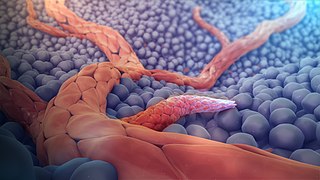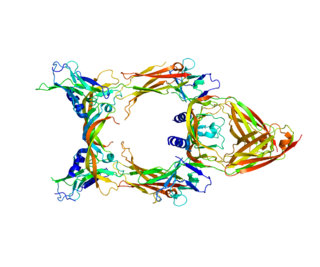Role in preeclampsia
The placental factor theory of preeclampsia
Preeclampsia is a pregnancy-specific condition characterized by maternal hypertension and proteinuria after the 20th week of gestation. [5] Normally, during early formation of the placenta, extravillous cytotrophoblasts, a type of specialized fetal cell, enter the spiral arteries of the uterus. This invasion spurs remodeling of the epithelial layer of these uterine arteries, increasing their conductance and decreasing their resistance to meet the increase blood flow demands of pregnancy. [10] [11] Specifically, invading cytotrophoblasts achieve this change by down-regulating the expression of adhesion molecules characteristic of epithelial cells and up-regulating the expression of adhesion molecules characteristic of endothelial cells in a process known as pseudovasculogenesis. [12] [13]
In preeclamptic patients, this arterial transformation is incomplete, as cytotrophoblasts fail to completely switch their adhesion molecule expression pattern to an endothelial form. The balance of pro- and anti-angiogenic factors and their receptors, including VEGF-A, PIGF, Flt1, and sFlt1, is thought to mediate this process. [5]
In women who develop preeclampsia, the sFlt-1 to PlGF ratio is higher than in normal pregnancy. [4] [14] [6] sFlt-1 produced in the placenta is thought to circulate in the maternal bloodstream to act on distant tissues, explaining the multi-system endothelial dysfunction observed in women with preeclampsia. [5] In-vitro studies have linked sFlt-1 treatment to a pattern of vasoconstriction and endothelial dysfunction identical to the syndrome produced when cells are incubated with serum from preeclamptic patients. [5] Additionally, adenoviral transfer of the sFlt-1 gene to pregnant rats has been shown to produce a syndrome similar to preeclampsia. [5]
Preeclamptic regulation of sFlt-1
Though sFlt-1 is produced in small amounts by endothelial cells and monocytes, the placenta is theorized to be the major source of sFlt-1 during pregnancy. [4] sFlt-1 mRNA shows strong expression in the placenta, and serum concentration of sFlt-1 falls significantly in patients after delivery of the placenta. [15] [16]
Expression of sFlt-1 is stimulated by hypoxic conditions. In healthy pregnancies, the placenta develops in a hypoxic environment, leading to a 20-fold increase in sFlt-1 expression. [17] In early-onset preeclamptic patients, this increase is estimated to be up to 43 times more pronounced, and may be spurred by conditions of poor uterine profusion leading to more severe local hypoxia. [18] Inhibition of nitric oxide signaling has also been associated with elevation of serum sFlt-1 in a rat model of preeclampsia; this stimulus may represent a secondary factor contributing to sFlt-1 trends in human preeclampsia as well. [19]
In addition to short-term regulation by oxygen and nitric oxide levels, genetic differences also influence Flt-1 gene splicing and resulting sFlt-1 expression levels. Women with histories of preeclampsia continue to show elevated serum levels of sFlt-1 up to 18 months postpartum, suggesting a genetic basis of sFlt-1 expression independent of pregnancy-related stimuli. [20]
Clinical significance
PlGF and sFlt-1 concentrations measured by immunoassay in maternal blood improve the prognostic possibilities in preeclampsia, which is typically diagnosed solely on the basis of clinical symptoms, proteinuria, and uterine artery Doppler velocimetry. [21] [22] Notably, increases in sFlt-1 and decreases in PIGF and VEGF can be detected at least five weeks before the onset of preeclamptic symptoms, potentially facilitating earlier diagnosis and treatment. [23] sFlt-1 changes are most predictive of early-onset preeclampsia; cases of preeclampsia incident late in pregnancy typically are accompanied only by small decreases in PIGF. [18] However, sFlt-1 elevation is also associated with other obstetric conditions such as non-preeclampsic interuterine growth retardation of the fetus, limiting its use as a discriminatory biomarker for preeclampsia. [24] Additionally, sensitivity and specificity of sFlt-1 testing is generally considered too low to enable it to serve as an effective predictor of preeclampsia. [25]
sFlt-1 involvement in the pathogenesis of preeclampsia may explain several demographic trends in incidence of the condition. The human Flt-1/sFlt-1 gene is located at 13q12; the association of fetal trisomy-13 with higher rates of preeclampsia could theoretically be explained by the additional copy of the gene. [5] Additionally, primiparous women have higher baseline levels of sFlt-1, a trend which could potentially explain the higher incidence of preeclampsia among first-time mothers. [5]

Angiogenesis is the physiological process through which new blood vessels form from pre-existing vessels, formed in the earlier stage of vasculogenesis. Angiogenesis continues the growth of the vasculature mainly by processes of sprouting and splitting, but processes such as coalescent angiogenesis, vessel elongation and vessel cooption also play a role. Vasculogenesis is the embryonic formation of endothelial cells from mesoderm cell precursors, and from neovascularization, although discussions are not always precise. The first vessels in the developing embryo form through vasculogenesis, after which angiogenesis is responsible for most, if not all, blood vessel growth during development and in disease.

Pre-eclampsia is a multi-system disorder specific to pregnancy, characterized by the onset of high blood pressure and often a significant amount of protein in the urine. When it arises, the condition begins after 20 weeks of pregnancy. In severe cases of the disease there may be red blood cell breakdown, a low blood platelet count, impaired liver function, kidney dysfunction, swelling, shortness of breath due to fluid in the lungs, or visual disturbances. Pre-eclampsia increases the risk of undesirable as well as lethal outcomes for both the mother and the fetus including preterm labor. If left untreated, it may result in seizures at which point it is known as eclampsia.
Vascular endothelial growth factor, originally known as vascular permeability factor (VPF), is a signal protein produced by many cells that stimulates the formation of blood vessels. To be specific, VEGF is a sub-family of growth factors, the platelet-derived growth factor family of cystine-knot growth factors. They are important signaling proteins involved in both vasculogenesis and angiogenesis.

Endostatin is a naturally occurring, 20-kDa C-terminal fragment derived from type XVIII collagen. It is reported to serve as an anti-angiogenic agent, similar to angiostatin and thrombospondin.

Receptor tyrosine kinases (RTKs) are the high-affinity cell surface receptors for many polypeptide growth factors, cytokines, and hormones. Of the 90 unique tyrosine kinase genes identified in the human genome, 58 encode receptor tyrosine kinase proteins. Receptor tyrosine kinases have been shown not only to be key regulators of normal cellular processes but also to have a critical role in the development and progression of many types of cancer. Mutations in receptor tyrosine kinases lead to activation of a series of signalling cascades which have numerous effects on protein expression. Receptor tyrosine kinases are part of the larger family of protein tyrosine kinases, encompassing the receptor tyrosine kinase proteins which contain a transmembrane domain, as well as the non-receptor tyrosine kinases which do not possess transmembrane domains.

Angiopoietin is part of a family of vascular growth factors that play a role in embryonic and postnatal angiogenesis. Angiopoietin signaling most directly corresponds with angiogenesis, the process by which new arteries and veins form from preexisting blood vessels. Angiogenesis proceeds through sprouting, endothelial cell migration, proliferation, and vessel destabilization and stabilization. They are responsible for assembling and disassembling the endothelial lining of blood vessels. Angiopoietin cytokines are involved with controlling microvascular permeability, vasodilation, and vasoconstriction by signaling smooth muscle cells surrounding vessels. There are now four identified angiopoietins: ANGPT1, ANGPT2, ANGPTL3, ANGPT4.

VEGF receptors (VEGFRs) are receptors for vascular endothelial growth factor (VEGF). There are three main subtypes of VEGFR, numbered 1, 2 and 3. Depending on alternative splicing, they may be membrane-bound (mbVEGFR) or soluble (sVEGFR).

Angiopoietin 1 is a type of angiopoietin and is encoded by the gene ANGPT1.

Vascular endothelial growth factor receptor 1 is a protein that in humans is encoded by the FLT1 gene.

Kinase insert domain receptor also known as vascular endothelial growth factor receptor 2 (VEGFR-2) is a VEGF receptor. KDR is the human gene encoding it. KDR has also been designated as CD309. KDR is also known as Flk1.

Vascular endothelial growth factor C (VEGF-C) is a protein that is a member of the platelet-derived growth factor / vascular endothelial growth factor (PDGF/VEGF) family. It is encoded in humans by the VEGFC gene, which is located on chromosome 4q34.

Neuropilin-1 is a protein that in humans is encoded by the NRP1 gene. In humans, the neuropilin 1 gene is located at 10p11.22. This is one of two human neuropilins.

Placental growth factor(PlGF) is a protein that in humans is encoded by the PGF gene.

Vascular endothelial growth factor A (VEGF-A) is a protein that in humans is encoded by the VEGFA gene.

Fms-related tyrosine kinase 4, also known as FLT4, is a protein which in humans is encoded by the FLT4 gene.

Tyrosine kinase with immunoglobulin-like and EGF-like domains 1 also known as TIE1 is an angiopoietin receptor which in humans is encoded by the TIE1 gene.

AEE788 is a multitargeted human epidermal receptor (HER) 1/2 and vascular endothelial growth factor receptor (VEGFR) 1/2 receptor family tyrosine kinases inhibitor with IC50 of 2, 6, 77, 59 nM for EGFR, ErbB2, KDR, and Flt-1. In cells, growth factor-induced EGFR and ErbB2 phosphorylation was also efficiently inhibited with IC50s of 11 and 220 nM, respectively. It efficiently inhibited growth factor-induced EGFR and ErbB2 phosphorylation in tumors for >72 h, a phenomenon correlating with the antitumor efficacy of intermittent treatment schedules. It also inhibits VEGF-induced angiogenesis in a murine implant model. It has potential as an anticancer agent targeting deregulated tumor cell proliferation as well as angiogenic parameters.

Linifanib (ABT-869) is a structurally novel, potent inhibitor of receptor tyrosine kinases (RTK), vascular endothelial growth factor (VEGF) and platelet-derived growth factor (PDGF) with IC50 of 0.2, 2, 4, and 7 nM for human endothelial cells, PDGF receptor beta (PDGFR-β), KDR, and colony stimulating factor 1 receptor (CSF-1R), respectively. It has much less activity (IC50s > 1 μM) against unrelated RTKs, soluble tyrosine kinases, or serine/threonine kinases. In vivo linifanib is effective orally in mechanism-based murine models of VEGF-induced uterine edema (ED50 = 0.5 mg/kg) and corneal angiogenesis (>50%inhibition, 15 mg/kg).

Asif Ahmed FRSB is a British-Indian vascular scientist, whose research focuses on reducing the risk of mortality and morbidity in pregnancy. He is the founder and former Pro-Vice-Chancellor and Executive Dean of Aston Medical School, Birmingham, and established the Aston Medical Research Institute, a university-wide multidisciplinary translational research entity at Aston University.

The Pregnancy Outcome Prediction (POP) Study is a prospective cohort study of 4,512 women who have never given birth, recruited at the Rosie Hospital between January 2008 and July 2012.




















